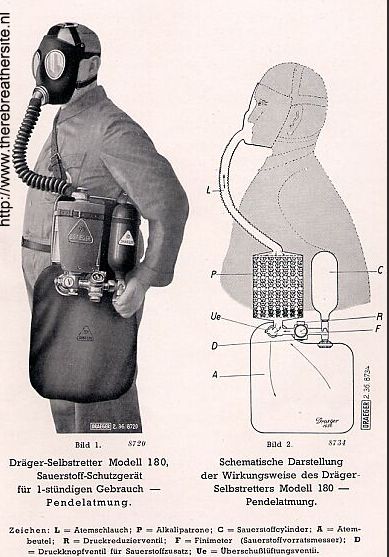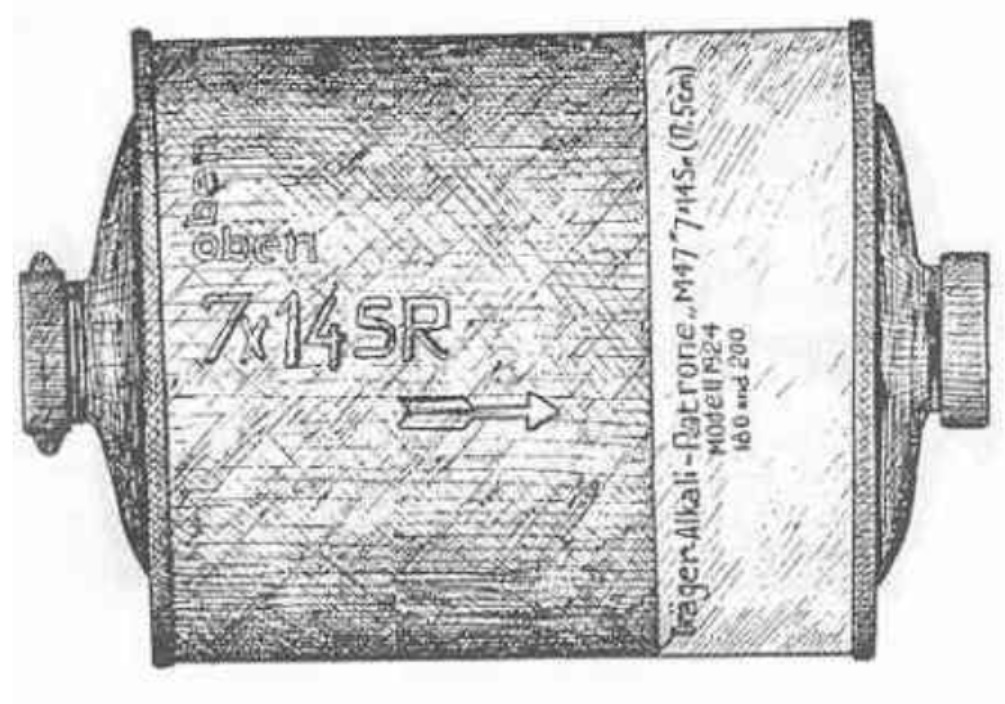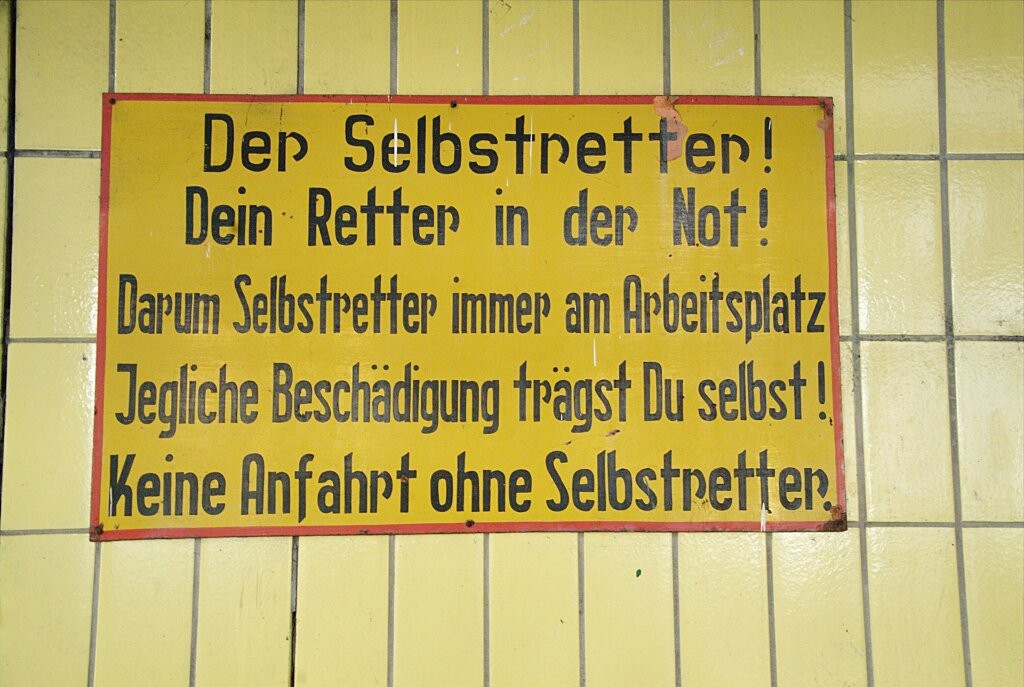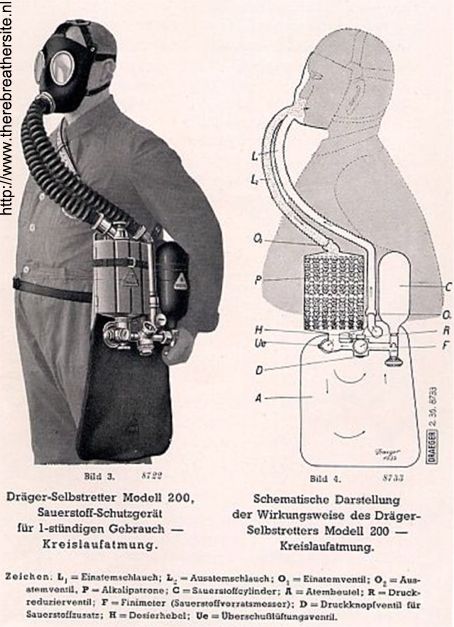
Development of mine escape apparatus 1938
Dräger Selbstretter Modell 180, 200 and 200A
The history of the development of self-contained breathing apparatus goes quite far back in time, though in the early days most of the attention was given to designing a unit to protect firemen from smoke inhalation.
One such design for firemen dates back to about 1825 when the “smoke filter” was used. It consisted of a leather hood and a hose that was strapped to one of the wearer’s leg. It did not contain its own supply of oxygen. Rather, it was designed so that when the wearer inhaled from inside the hood, air would be drawn up through the hose.
The idea behind this design was that the best air during a fire is closest to the floor. The hose and hood was intended to provide this better air to the firemen as they worked in smoke.
Soon after, equipment was designed to provide the firemen with good safe air to breathe for short periods of time. One such design was the “supplied air suit” which was filled with fresh air to breathe.
Another design for firefighters was a bag-like unit filled with fresh air and carried on one’s back, much like some of today’s units.
Underwater divers also used some of the first self contained breathing apparatus developed.
Then, in 1853, self-contained breathing apparatus was introduced for use in the mines by a Professor Schwann of Belgium. In that year, Schwann entered a self-contained breathing apparatus in a competition of the Belgian Academy of Science, and exhibited it at an industrial fair in Belgium.
In 1880, the original Fleuss apparatus was introduced in England, and in 1903 the original Draeger apparatus was developed in Germany.
In the United States, breathing apparatus were introduced in 1907 when five Draeger units were purchased by the Boston and Montana Mining Company in Butte, Montana.
Records show that also in 1907, apparatus were first used to fight fires and explore ahead of fresh air in the mines:
1. In October or November of 1907, Draeger apparatus were used by a crew of men during the fighting and sealing of a mine fire at the Minnie Healy Mine of the Boston and Montana Mining and Smeiting Company in Butte, Montana.
2. On December 6, two Draeger apparatus were used to explore ahead of fresh air after an explosion in the Monongah Mine of the Consolidated Coal Company in Monongah. West Virginia.
3. On December 19, apparatus were used after an explosion in the Darr Mine of the Pittsburgh Coal Company in Jacobs Creek, Pennsylvania.
In 1910, the Bureau of Mines was established. The Bureau began equipping mine rescue railroad cars and stations with apparatus and began training miners in the use and care of the breathing apparatus. Thus, the equipment necessary for rescue work and the trained teams to use it gradually became more available to the mines.
At first, all the apparatus used in this country were imported from Europe. Then in 1918, the Gibbs apparatus was designed and manufacture. This was followed by the Paul in 1920 and the McCaa in 1927. These early American-made apparatus were designed for 2-hour use.
The development of self-contained breathing apparatus has continued to progress through the years. A number of different manufacturers are now producing apparatus that are approved to be used for periods of 2, 3, and 4 hours at a time. Among these apparatus commonly used for mine rescue work are the Draeger BG 174, the Aerolox, and the Scott Rescue-Pak.
III. Types of SCBA
a. Open and Closed Circuit SCBA- Self-contained breathing apparatus can be divided into two main categories: open circuit systems and closed circuit systems. The basic difference between the two systems is this: An open circuit system releases all of your exhaled air (carbon dioxide) to the outside atmosphere through a valve in the facepiece, and supplies you with fresh air to breathe. A closed circuit system does not release the exhaled air. Rather, it recirculates the air through the apparatus and purifies the air, taking out the carbon dioxide and adding fresh oxygen to the air. You are then supplied with the air that has been oxygen enriched.
b. Primary and Auxiliary SCBA- In mine rescue work, apparatus are classified as being either “primary” or “auxiliary” apparatus depending on how much air or oxygen they can supply to you when you wear them. Primary apparatus are apparatus that have a minimum of 2 hours’ service time. Auxiliary apparatus are units which provide, by law, 30 to 60 minutes’ service time.
Primary apparatus are the standard apparatus that mine rescue teams use. Part 49 of Title 30 of the Code of Federal Regulations (30 CFR) specifies that rescue teams must be provided with self-contained breathing apparatus that have at least a 2-hour service time and are approved under Federal guidelines.
Auxiliary apparatus are only acceptable for a mine rescue team member to use so long as the team member has ready access to fresh air and has at least one rescue team equipped with an approved self-contained breathing apparatus of 2-hours or longer rating in reserve at the fresh air base.
Auxiliary apparatus may either be open or closed circuit systems. Primary apparatus, on the other hand, are designed as closed circuit systems.
c. Apparatus Approval- In order for any self-contained breathing apparatus to be used in mine rescue work, the apparatus must first be approved by the Federal movement.
Back in 1918, the Bureau of Mines began to test and approve apparatus under Schedule 13 which established the standards for approval.
Today, the testing of the apparatus is handled by the National Institute for Occupational Safety and Health (NIOSH). The apparatus approval is granted jointly by NIOSH and the Mine Safety and Health Administration (MSHA).
IV. History of mine rescue
a. Helmet Crews- In 1910, however, the U.S. Bureau of Mines was formed, and with it came the organization, training, and ”team” element that mine rescue so badly needed.
The Bureau established a network of specially outfitted railroad cars and placed them at strategic locations throughout the mining areas of the United States. Each car served as a base of operations for a group of individuals trained and equipped specifically for mine rescue work.
Because their breathing gear’s full head covering resembled a deep sea diver’s helmet, the groups became known as “helmet crews.” The crews were trained to respond quickly and professionally to disasters in their own districts, much as modern teams do.
The new helmet crews were called on to lend a hand at several major disasters, and they were responsible for saving the lives of scores of trapped miners. Although the crew’s access to breathing gear and other equipment was a great help to them, their success could be attributed to more than that.
For the first time, the rescuers had the training and organization they needed to turn an uncoordinated, often even chaotic, rescue attempt into a well coordinated efficient group effort. The birth of the early helmet crews clearly marked the beginning of modern mine rescue teams.
b. The 1940’s- In the 1940’s, World War II spurred increasing demand for mined products, so more miners were put to work. At the same time, the mines were becoming more highly mechanized. These factors combined to produce more hazards, and the result was more chance for disaster.
In terms of sheer numbers, the disaster statistics of the 40’s came nowhere near matching those of earlier years, but they were nonetheless sobering. In 1940, for example, the Bartley No. 1 coal mine in West Virginia claimed 91 lives. In 1942. 56 died in the Christopher No. 3 coal mine disaster also in West Virginia. And a disaster at the Centralia No. 5 coal mine in Illinois claimed 111 lives in 1947.
These tragedies pointed to the need for preventing disasters by reducing the hazards that led to them. There were big changes afoot. Even though mining was a hazardous occupation, there were ways to make it safer.
On the state and Federal levels, this meant establishing and enforcing laws aimed at making the mines safer places in which to work. Mining companies also joined in the effort to reduce mining hazards by developing safety programs and improving conditions within the mines. To some extent, the changes worked. The number of disasters decreased, as did the number of those who died in them.
Today, great emphasis is still placed on establishing and enforcing mine health and safety regulations. This continues to significantly reduce mining hazards. Modern technological advances and increased mechanization have also made it possible for fewer miners to remove ever-increasing amounts of materials from beneath the earth’s surface. This reduction in the number of man-hours required to do work has also reduced the chance for disaster.
All these developments have occupied designers of rescue appliances since the early 20th century. Rescue appliances were initially large and cumbersome. There was a great need for small compact units that could be carried on the man. This led to the development of Self-rescuers, a personal device which the miner carries with him to escape safely in case of emergency.
A major contribution an the technology used is the development of an oxygen candle. After ignition, this candle produces oxygen that can be breathed by the wearer of the device. As a result, the presence of a gas cylinder containing oxygen is no longer necessary and the devices could be produced significantly smaller. The oxygen candle often needs to be activated with an igniter. The igniter is often of a pyrotechnic design that is started by a mechanical action. The CO2 exhaled by the wearer enters a scrubber through a closed circuit that scrubs out the CO2 after which the remaining oxygen is replenished with new gas. So the user can breathe from a device the size of a lunchbox for half an hour or even an hour in a toxic atmosphere. These devices should not be used as rescue equipment, but only to escape from toxic atmospheres.
An example of early devices to function this way were the Draeger Selbstretter modell 180, 200 and 200 A as shown in the photos below.





Therebreathersite was founded by Jan Willem Bech in 1999. After a diving career of many years, he decided to start technical diving in 1999. He immediately noticed that at that time there was almost no website that contained the history of closed breathing systems. The start for the website led to a huge collection that offered about 1,300 pages of information until 2019. In 2019, a fresh start was made with the website now freely available online for everyone. Therebreathersite is a source of information for divers, researchers, technicians and students. I hope you enjoy browsing the content!
